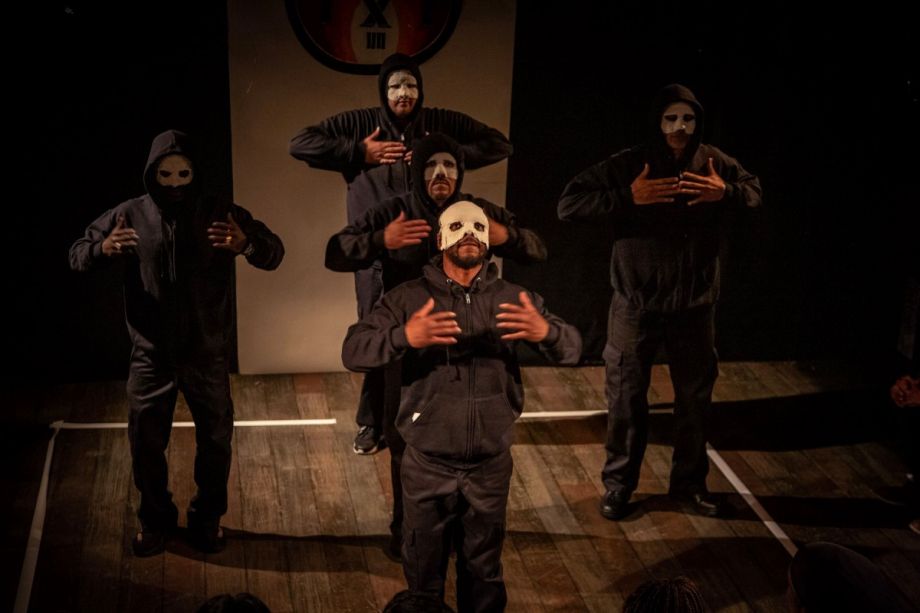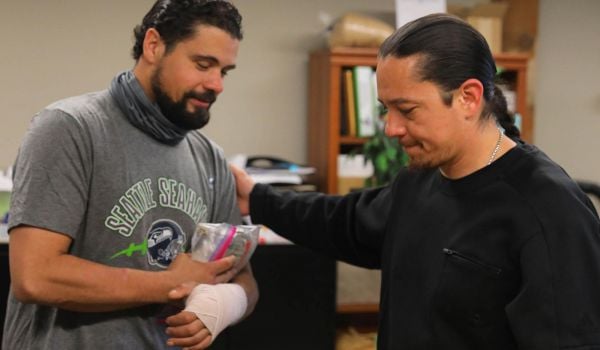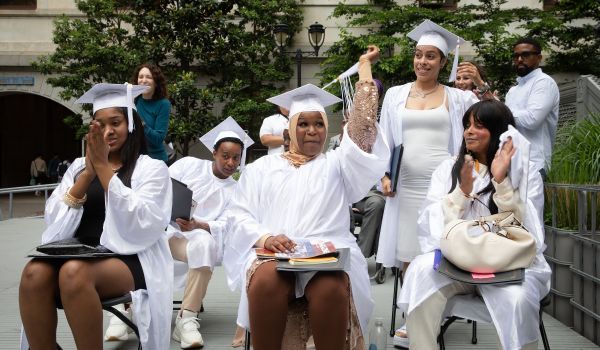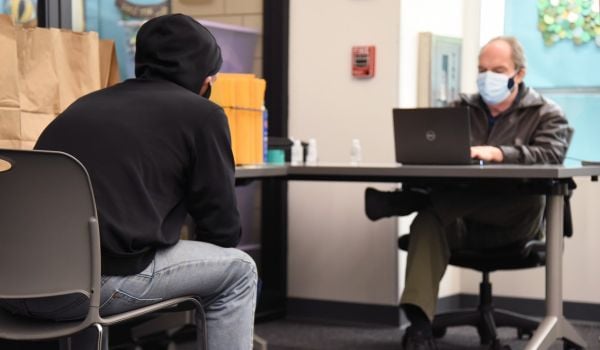A decade ago, Alex Anderson “crossed the threshold” from one life to another. In his first life, he had been incarcerated in New York, left prison, and got involved with a number of programs but struggled with the shame of his incarceration. In the other, he stopped judging himself and found new self-acceptance and self-worth.
The bridge between those two lives was Ritual4Return, a program guiding formerly incarcerated men and women through a process of creating and performing a rite of passage, with a goal of transitioning from incarceration back into the community.
“The whole idea of healing from the shame and trauma of incarceration — no one really talks about it,” Anderson says. “It’s usually, in criminal justice, about getting ahead of those feelings or putting them behind you and moving on. But we really don’t put them behind us. They stay with us.”
Anderson’s desire to confront those feelings lined up with the work of Kevin Bott, a community-based theater artist studying “rites of passage” for formerly incarcerated men for his doctoral dissertation. The pair, alongside four other formerly incarcerated individuals, developed what would be Ritual4Return’s first rite of passage: a participatory, theatrical event by the men with each performing a threshold crossing before family and friends, signifying the transition into the next stage of their lives.
“I crossed the threshold in 2009 … it was transformative,” says Anderson. “I knew if it could work for me, it could work for others.” And so on a Monday evening this winter, at the Stella Adler Studio of Acting in Downtown Manhattan, he sat on a folding chair inside a bare rehearsal room to assist a group of formerly incarcerated women with their own.
The women’s cohort marks a turning point for the organization. Over the past 10 years, Bott continued his community-based arts practice and worked in academia, while Anderson held a career in social work. But in the past year Bott secured enough funding to turn his full-time attention to Ritual4Return and bring on Anderson as partner. This past spring, Ritual4Return hosted its first rite of passage since the inaugural one in 2009. This weekend, the organization’s first female cohort, a group of 10 formerly incarcerated women, will enact theirs at The National Black Theater in Harlem.
To develop Ritual4Return, Bott studied a 50-year body of literature in criminology and sociology on the potential of rites of passage and storytelling tools for people leaving prison, including But They All Come Back by Jeremy Travis and Making Good by Shadd Maruna. But after he completed his dissertation in 2010 — which examined the ethical aspects of creating a rite of passage with formerly incarcerated individuals — he struggled to convince funders and partners of the work’s value.
“It was really outside the box — this intersection of healing, arts and movement building — in a way that neither the criminal justice folks or the theater folks could understand,” he says.
Over the years — as the number of people incarcerated or under community supervision has maintained record-high levels — he witnessed a shift. “We’ve heard and witnessed all these stories that make it real obvious that this isn’t about bad choices people make, or people needing to be rehabilitated, these are system and structural issues,” he says of mass incarceration.
In the summer of 2018, Bott met Tom Oppenheim, the artistic director of the Stella Adler Studio of Acting, which is the leading arts provider at Rikers Island. Oppenheim was intrigued by Ritual4Return’s potential and committed to helping Bott and Anderson.
A successful Kickstarer campaign was backed by additional funding from New York Humanities and Columbia University Justice Lab. The team launched the men’s cohort in March of 2019 and guided them through the process of creating their rites of passage this June.
In September, supported by funding from A Blade of Grass, the David Rockefeller Foundation and private donors, Ritual4Return recruited 10 women, who have met over 12 Monday nights this fall preparing for their December 14th rite of passage. Participants all receive meals, subway fare and a $500 stipend for their participation.
“I wanted to find out more about what’s missing in my life, or what I need,” says Chermaine Black, who commutes from Pennsylvania for the weekly workshops. “I’ve had to bring my whole self to this experience.”
Early this month, Black was tucked in a corner of the rehearsal room, brainstorming a rite of passage poem on a laptop. Bott was nearby, carefully layering one woman’s face with a plaster mask that each woman would wear throughout the rite of passage, before removing at the end. Small groups, assisted by Anderson and two volunteers, fine tuned each woman’s work.
The women experimented with poetry, spoken word, dance and song to talk not only about incarceration, but pasts that included rape, molestation, postpartum depression, poverty and addiction. They spoke of being sisters, daughters, mothers and grandmothers. One women tested ways to address her audience as she asked the question “Am I really free?”
“We’re going from our experiences as a young kid until now and then looking at how it comes out in the conversations and work we’re doing,” Black explains. “I believe it’s one of the major pieces of the threshold crossing that I was looking for.”
Anderson recalls this as intensive, challenging work, from being more open in his movement (“Incarceration can make people very stiff and very rigid … I spent a lot of time in cells,” he explains) to tapping into feelings like rejection that he bottled long ago.
But delving into the past is tied to setting a vision for the future, one in which “I could transform myself into something I really wanted to be,” Anderson says. For the women’s cohort, “it’s about women being women — it’s not just about women being formerly incarcerated,” notes Black.
Bott compares the culminating “threshold crossing” — in which the participants perform their piece surrounded by family and friends — as setting vows, with the audience as witness. After each participant removes their mask, they are joined on stage by a loved one and recite a short vow expressing their commitment in their new life chapter. “The audience is invested, and there’s an emotional catharsis there,” he says.
“It’s a magical place,” Anderson believes, speaking not only about the rite of passage but also the vulnerable, collaborative space participants build upon, week after week.
For Black, who points to the sharp rise of women incarcerated in the U.S., the work has a deeper message. “Women are the stronghold of their community … they hold up their children, their partners — so what does it say when they’re missing?” she asks. “We need people to know our struggles, to remember, and not forget.”
This article is part of “For Whom, By Whom,” a series of articles about how creative placemaking can expand opportunities for low-income people living in disinvested communities. This series is generously underwritten by the Kresge Foundation.

Emily Nonko is a social justice and solutions-oriented reporter based in Brooklyn, New York. She covers a range of topics for Next City, including arts and culture, housing, movement building and transit.
Follow Emily .(JavaScript must be enabled to view this email address)
















